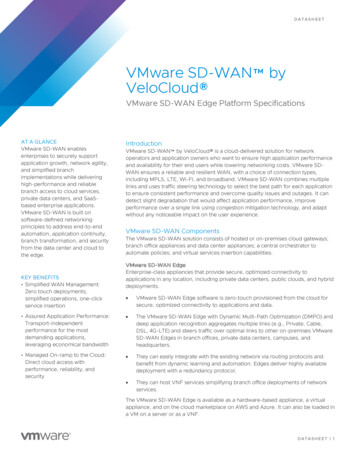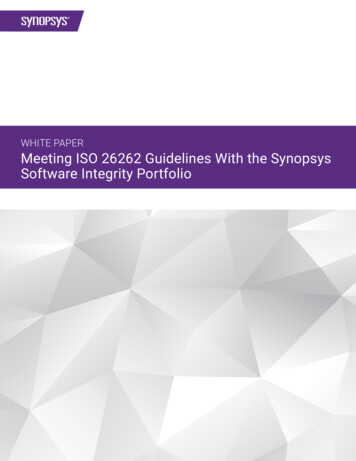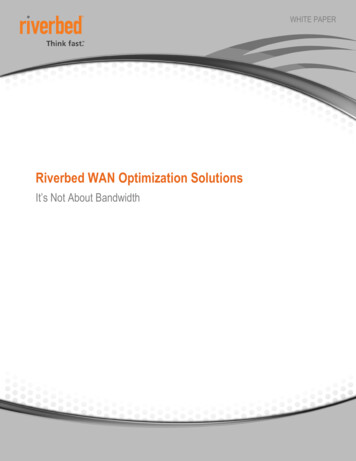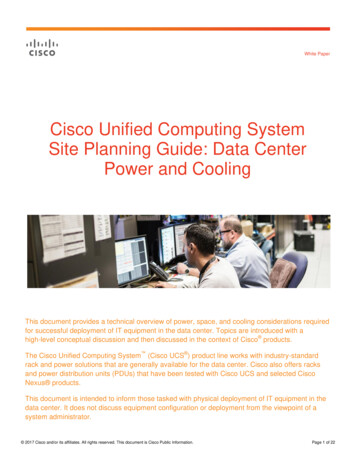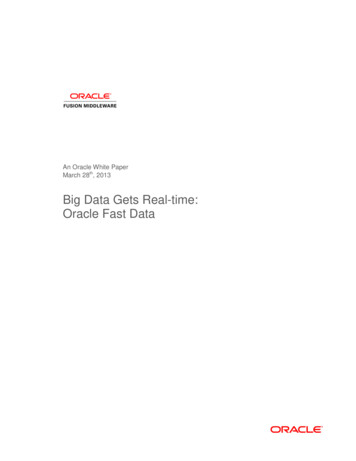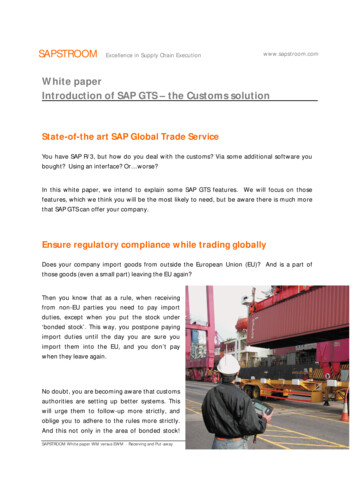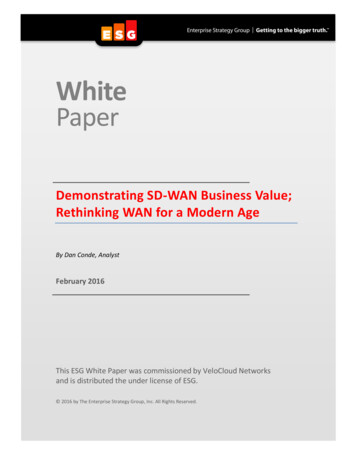
Transcription
WhitePaperDemonstrating SD-WAN Business Value;Rethinking WAN for a Modern AgeBy Dan Conde, AnalystFebruary 2016This ESG White Paper was commissioned by VeloCloud Networksand is distributed the under license of ESG. 2016 by The Enterprise Strategy Group, Inc. All Rights Reserved.
White Paper: SD-WAN Business Value2ContentsIntroduction . 3Changes in Application Use . 3CapEx-centric Data Centers Are Getting Outdated . 3Data Costs Are not the Only Source of Savings . 3Revisit the WAN Architecture. 3WAN Challenges Are Varied . 4A Better Solution. 5Case Studies . 5Reducing the Total Cost of Ownership (TCO) for WAN Solutions . 6The Three Way Benefits . 6How to Make a Transition?. 10Conventional Infrastructure—Choosing a Transition . 10SD-WAN Method—Different Paths to Adoption . 12The Bigger Truth . 14All trademark names are property of their respective companies. Information contained in this publication has been obtained by sources TheEnterprise Strategy Group (ESG) considers to be reliable but is not warranted by ESG. This publication may contain opinions of ESG, which aresubject to change from time to time. This publication is copyrighted by The Enterprise Strategy Group, Inc. Any reproduction or redistribution ofthis publication, in whole or in part, whether in hard-copy format, electronically, or otherwise to persons not authorized to receive it, without theexpress consent of The Enterprise Strategy Group, Inc., is in violation of U.S. copyright law and will be subject to an action for civil damages and,if applicable, criminal prosecution. Should you have any questions, please contact ESG Client Relations at 508.482.0188. 2016 by The Enterprise Strategy Group, Inc. All Rights Reserved.
White Paper: SD-WAN Business Value3IntroductionWide area network (WAN) infrastructure that connects enterprise branch offices has not changed for many years.Developments such as WAN optimization have provided incremental and measurable improvements inperformance and cost containment. As a result, WAN infrastructure planning was easy, as changes werepredictable, and increases in capacity were met by provisioning additional carrier MPLS (multiprotocol labelswitching) network capacity. Due to the increased adoption of software-as-a-service (SaaS), the nature ofapplication usage and related data center use are changing at a rapid pace, and traditional methods for meetingthose networking needs are neither cost-effective nor responsive enough to meet business needs. Modern usersought to demand a better solution.Changes in Application UseApplication use in enterprises is changing from a model in which they are hosted within an enterprise data centertowards a SaaS model. Sometimes these changes are planned or sometimes they gradually happen in a moreorganic fashion, but in either case, it changes the requirements of the network infrastructure. Network traffic to thedata center is becoming less relevant, as the remote locations demand an increasing amount of traffic that goesdirectly to the Internet, bypassing the data center altogether.This means that legacy architectures are no longer suited for the network traffic patterns required today. Trafficdestined for SaaS destinations will first travel through the conventional MPLS WAN to arrive at the data center, onlyto exit the data center and arrive at the SaaS vendor’s data center. In technology terms, this is called the WANtraffic trombone or hair pinning through the data center. This wasteful diversion of traffic results in poorperformance, as the network traffic traverses through multiple hops in the network. No wonder that in some cases,remote end-users prefer to work from home, or visit a public Internet access point such as a coffee shop to gainbetter performing application access.Not only are bandwidth requirements to the Internet changing, but the nature of network access has also oftenbecome more demanding. Network-based unified communication (UC) and voice over IP (VOIP) have increased inuse. These models may utilize desk phones that transmit over the network, or voice apps such as Skype for Businessthat run on computers or tablets. In either case, the demands are the same, since voice traffic is more sensitive tothe quality of the network traffic transmission than conventional web text data traffic. Slight disruption in timelydelivery of packets results in lower voice quality. These new forms of communication require better managementof network traffic latency, packet loss, jitter, and a dynamic quality of service (QoS).CapEx-centric Data Centers Are Getting OutdatedA data center that serves as a hub for branches is CapEx-centric due to its complicated architecture and inability toscale well as the number of branches grows. Network infrastructure design in data centers was created whenapplications were primarily presented from within the data center. As applications migrate to the cloud, thehardware architecture is starting to show a mismatch with the demands found in practice.Data Costs Are not the Only Source of SavingsMany customers who seek to refresh the WAN infrastructure focus on the potential data savings by usingalternative networking technology to reduce MPLS costs. However, that is only part of the story. Operationalexpenditure (OpEx) costs are also important and it is additionally important to reduce friction in IT operations.Sending staff to troubleshoot via truck rolls (service visits) adds costs and time to problem resolution, so customersneed to evaluate savings from many angles.Revisit the WAN ArchitectureFor these reasons, we need to revisit the traditional WAN architecture. Traditional architectures were designed foran old world. The hub-and-spoke model was data-center-focused and suitable for the days when the vast majority 2016 by The Enterprise Strategy Group, Inc. All Rights Reserved.
White Paper: SD-WAN Business Value4of applications were client-server-based and hosted in the data center. There is a mismatch in the architecture,which also results in higher costs. The WAN is designed to be over-provisioned to handle the worst case, which isthat when all the WAN sites access the data center (whether accessing data center apps or Internet SaaS apps), itwill potentially concentrate all their traffic in the data center. But, given this traditional architecture, this is the onlyway to ensure that the network behaves as the end-users expect.WAN Challenges Are VariedIn order to determine the IT priorities and challenges when it comes to supporting the technology requirements ofremote office/branch office (ROBO) locations, and how organizations plan to address those challenges, ESGsurveyed 347 North American senior IT professionals representing midmarket (100 to 999 employees) andenterprise-class (1,000 employees or more) organizations.When respondents were asked about the biggest networking challenges they face when it comes to supporting ITrequirements for remote office/branch office (ROBO) locations, the top responses were slow file transfer speed(36%) and cost of WAN bandwidth (32%). ESG believes that the fact that not one challenge dominated theresponses indicates that organizations encounter a wide variety of challenges and incur associated costs. It isimportant to note, however, that costs vary depending on the number of locations, how dispersed they are, andthe quality of the network service and equipment providers (see Figure 1).1Figure 1. Challenges for Supporting IT Requirements for ROBO LocationsWhat challenges – if any – has your organization experienced in terms of delivering businessapplications and/or IT services from a centralized location such as a corporate data center orthird-party cloud service provider over the WAN to your ROBO locations? (Percent ofrespondents, N 347, multiple responses accepted)Slow file transfer speed36%Cost of WAN bandwidth32%Too much data to move over WAN30%Technical challenges make collaboration with other partsof the organization difficultInstalling and maintaining agents on devices at ROBOlocations29%27%Lack of data/application consistency27%Difficulty securing data in transit26%Poor application performance25%Unreliable end-user access for ROBO-based employees24%Lack of available WAN infrastructure/telco services20%We have not experienced any challenges11%0%10%20%30%40%Source: Enterprise Strategy Group, 20161Source: ESG Research Report, Remote Office/Branch Office Technology Trends, May 2015. 2016 by The Enterprise Strategy Group, Inc. All Rights Reserved.
White Paper: SD-WAN Business Value5A Better SolutionA WAN designed to meet the modern requirements of branch offices can reduce costs and increase service levels.This solution needs to address multiple pain points in the following ways: Network infrastructure simplification: Reduce unnecessary deployment and management of networkinfrastructure, such as head-end devices or appliances at branches, if they can be replaced by modernalternatives that combine multiple functions into simple appliances, augmented by cloud-hosted services. Operational expenses: Create a zero-touch deployment model that reduces truck rolls, onsite remoteinstallation, configuration complexity, operations, management, and troubleshooting. In the same way thatSaaS has modernized application deployment and management, the supporting network infrastructureneeds to change accordingly to support this new model. Bandwidth cost reduction: A hybrid WAN that combines multiple transports such as MPLS networks alongwith broadband Internet links, controlled via a centralized orchestration system for policy management,monitoring, and troubleshooting, will meet these needs. By creating a unified network composed ofdifferent connections at the back-end, customers remove the need for disruptive changes to theapplication infrastructure, and minimize the changes needed for the network configurations.Note that there is often a misconception that hybrid WAN (a combination of multiple WAN paths) is the same asSD-WAN. ESG considers hybrid WAN to be a subset of SD-WAN, which offers multiple benefits and additionalcapabilities such as managing services. Although managing multiple hybrid network paths will enable savings byreducing MPLS costs, it cannot offer the variety of savings on OpEx or network infrastructure costs.Case StudiesLet us examine some case studies from customers to illustrate this. Devcon Construction, a California-based construction company, supports up to 50 construction sites inCalifornia and Nevada. They prefer T1 and MPLS networks for reliability but may also use less reliable DSL,cable, and 4G wireless to connect their offices, since MPLS networks are not always available to beprovisioned and when they are available may take days or weeks to provision. Use of unreliableconnections led to problems for their VoIP and video collaboration. A large building blueprint file transferwould overwhelm the available bandwidth needed by other users and lack of visibility led to difficulties introubleshooting. At least 20% of the sites required on-site IT visits for configuration, test, and provisioning.With VeloCloud, they have documented reduction of truck rolls to each branch for deployment andreduced multiple visits for configuration changes and for recurring troubleshooting visits. This enabledthem to lower their WAN costs by 75% and reduce operating expenditures (OpEx) by 50% due to reducedon-site visits. Most importantly, they were able to get their work done and enable project managers toreliably and efficiently hold meetings via VoIP. Redmond Inc., a manufacturer in Utah, relies on centralized VoIP and virtual desktop services hosted in itsprivate data center and made available to every branch office location. By switching to VeloCloud SD-WANand combining a network provided by cable, DSL, fiber, or 4G/3G wireless, they were able to install branchoffice equipment in about 30 minutes and avoid spending 40K per site in equipment upgrades. Thisresulted in a dramatic reduction of deployment time to hours down from weeks. There was no need toinstall data center hardware, such as a traditional head-end aggregation router, in order to retain highavailability capability. By reducing the need to maintain hardware at the regional hub data center andmoving the services to a cloud pr
become more demanding. Network-based unified communication (UC) and voice over IP (VOIP) have increased in use. These models may utilize desk phones that transmit over the network, or voice apps such as Skype for Business that run on computers or tablets. In either case, the demands are the same, since voice traffic is more sensitive to
